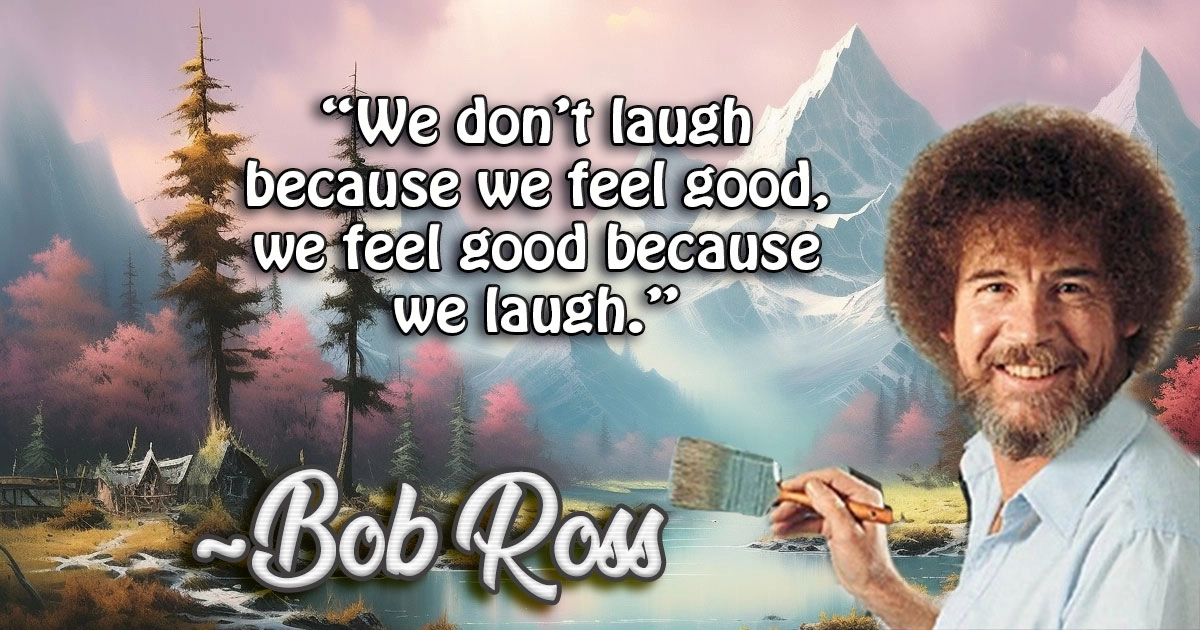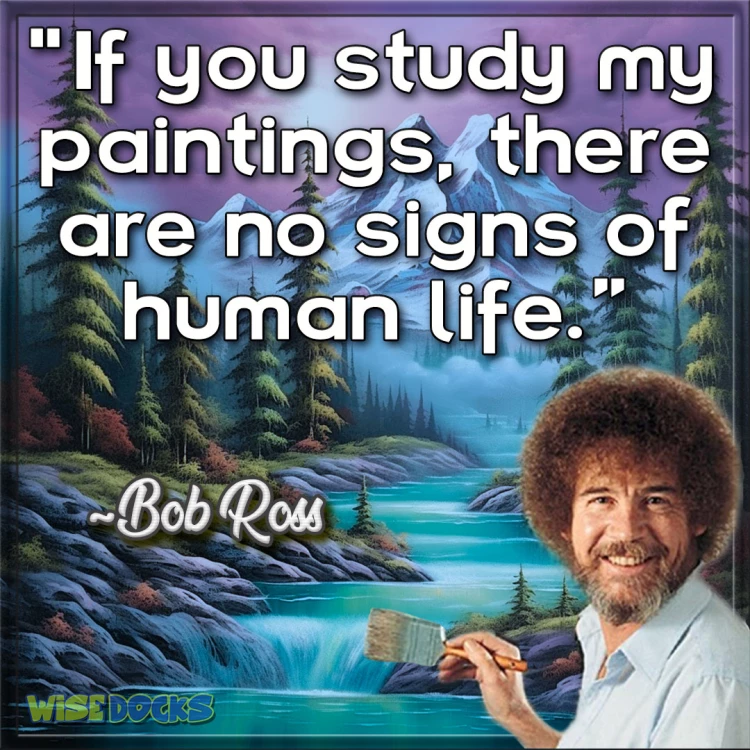Bob Ross: The Gentle Brush of Nature

Bob Ross
Bob Ross, born Robert Norman Ross on October 29, 1942, in Daytona Beach, Florida, became an enduring symbol of gentle encouragement and creativity. As a painter, art instructor, and television host, he captured the hearts of millions with his soothing voice, calm demeanor, and the remarkable ability to transform blank canvases into serene landscapes.

Early Life and Military Career
Bob Ross grew up in Orlando, Florida. His early life was marked by a love for animals and a fascination with nature. However, his path to becoming an artist was not straightforward. At the age of 18, Ross enlisted in the United States Air Force. During his 20-year military career, he was stationed in Alaska, where the breathtaking landscapes left an indelible mark on his artistic sensibilities.
Alaska's majestic mountains, serene lakes, and dense forests provided Ross with endless inspiration. Despite the rigorous demands of his military duties, he found solace in painting, often spending his free time capturing the Alaskan wilderness on canvas. His work as a drill sergeant, which required a stern and authoritative demeanor, contrasted sharply with the gentle and kind persona he would later embody.

The Joy of Painting
After retiring from the Air Force with the rank of Master Sergeant, Ross dedicated himself to art full-time. He studied under Bill Alexander, a German painter and television host known for his wet-on-wet oil painting technique. This method, which involves applying wet paint onto wet paint, allowed for a faster painting process and created the soft, blended look characteristic of Ross's landscapes.
In 1983, Bob Ross took a bold step that would change the course of his life and art. He launched his own television show, "The Joy of Painting," which aired on PBS. The show's premise was simple: in each episode, Ross would complete a painting from start to finish, demonstrating his techniques and encouraging viewers to follow along.
The Impact of "The Joy of Painting"
"The Joy of Painting" became an unexpected sensation. Ross's gentle voice, positive affirmations, and the serene beauty of his landscapes resonated with audiences. Phrases like "happy little trees," "there are no mistakes, only happy accidents," and "let's add a little more color here" became part of the cultural lexicon.
Ross's approach was revolutionary because it demystified art. He made painting accessible to everyone, emphasizing that anyone could create beautiful artwork with practice and patience. His encouragement extended beyond the canvas; he often spoke about the therapeutic and meditative benefits of painting, creating a sense of calm and relaxation for his viewers.
The show ran for 31 seasons, from 1983 to 1994, producing over 400 episodes. Despite its humble production values, "The Joy of Painting" attracted a diverse audience, including seasoned artists, amateurs, and people who simply enjoyed watching Ross's creative process. His gentle demeanor and encouraging words provided comfort to many, making the show a beloved staple of public television.
The Technique and Style of Bob Ross
Bob Ross's painting style is instantly recognizable. He primarily used oil paints and favored a palette knife and large brushes to create his signature landscapes. His technique, inspired by his mentor Bill Alexander, allowed him to complete a painting in about 30 minutes, the duration of a single episode.
Ross's paintings often featured natural elements: towering mountains, tranquil lakes, dense forests, and rustic cabins. His use of color was both vibrant and subtle, capturing the varied hues of nature with remarkable precision. He had a particular fondness for depicting the changing seasons, with autumnal scenes being among his most popular.

One of the distinctive features of Ross's technique was his ability to create depth and texture. He often used a palette knife to apply thick layers of paint, giving the impression of rugged mountain peaks or the rough bark of trees. His mastery of light and shadow added realism and dimension to his work, making each painting feel like a window into a serene, untouched wilderness.
Legacy and Influence
Bob Ross's influence extends far beyond the realm of art. He became a cultural icon, symbolizing creativity, positivity, and the therapeutic power of art. His philosophy of embracing mistakes and finding joy in the process resonated with people from all walks of life.
After his death in 1995, Ross's legacy continued to grow. The Bob Ross Art Workshop and Gallery in New Smyrna Beach, Florida, and the Bob Ross Inc. company, which he co-founded, have helped preserve his techniques and philosophy. His paintings, once considered simple instructional tools, are now recognized as valuable works of art, with some selling for thousands of dollars.
In recent years, there has been a resurgence of interest in Bob Ross and his work. The advent of the internet and streaming platforms introduced a new generation to "The Joy of Painting." Clips from the show went viral, and entire episodes were made available on platforms like YouTube and Twitch, where fans could watch and even paint along in real-time.
This renewed interest also sparked a broader appreciation for Ross's contributions to art and culture. He was featured in documentaries, parodied in popular media, and celebrated in exhibitions. The soothing quality of his voice and the calming nature of his paintings found a new audience in a world increasingly in need of peace and relaxation.
The Philosophy of Bob Ross
At the heart of Bob Ross's appeal was his philosophy of life and art. He believed that art should be accessible to everyone and that the act of creation could bring joy and tranquility. His emphasis on the process over the product encouraged people to embrace their creativity without fear of judgment or failure.
Ross's approach to painting was deeply therapeutic. He often spoke about the meditative aspects of painting, how it allowed one to escape the stresses of daily life and find peace in the act of creation. This perspective resonated with many viewers, who found solace in his gentle guidance and the serene worlds he created on canvas.
His famous catchphrase, "there are no mistakes, only happy accidents," encapsulated his positive outlook on life. It encouraged viewers to see beauty in imperfection and to approach challenges with a sense of optimism and resilience.
Bob Ross's legacy is a testament to the enduring power of art and the profound impact of kindness and encouragement. Through his television show, he brought the joy of painting into millions of homes, inspiring countless people to pick up a brush and discover their creativity.
His gentle voice, positive affirmations, and the serene beauty of his landscapes continue to inspire and comfort people around the world. Bob Ross showed us that art is not just about creating something beautiful; it's about finding joy in the process, embracing our imperfections, and connecting with the world around us.
In a world that often feels chaotic and stressful, Bob Ross's message of peace, creativity, and positivity remains as relevant as ever. His legacy lives on in the hearts of those who find solace in his words and inspiration in his art, proving that the gentle brush of nature can touch the soul and transform lives.
